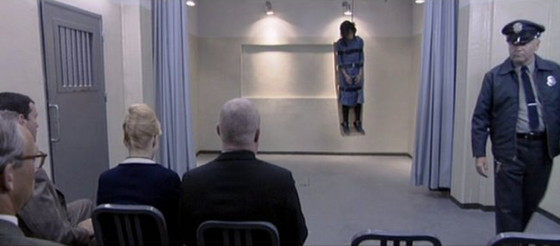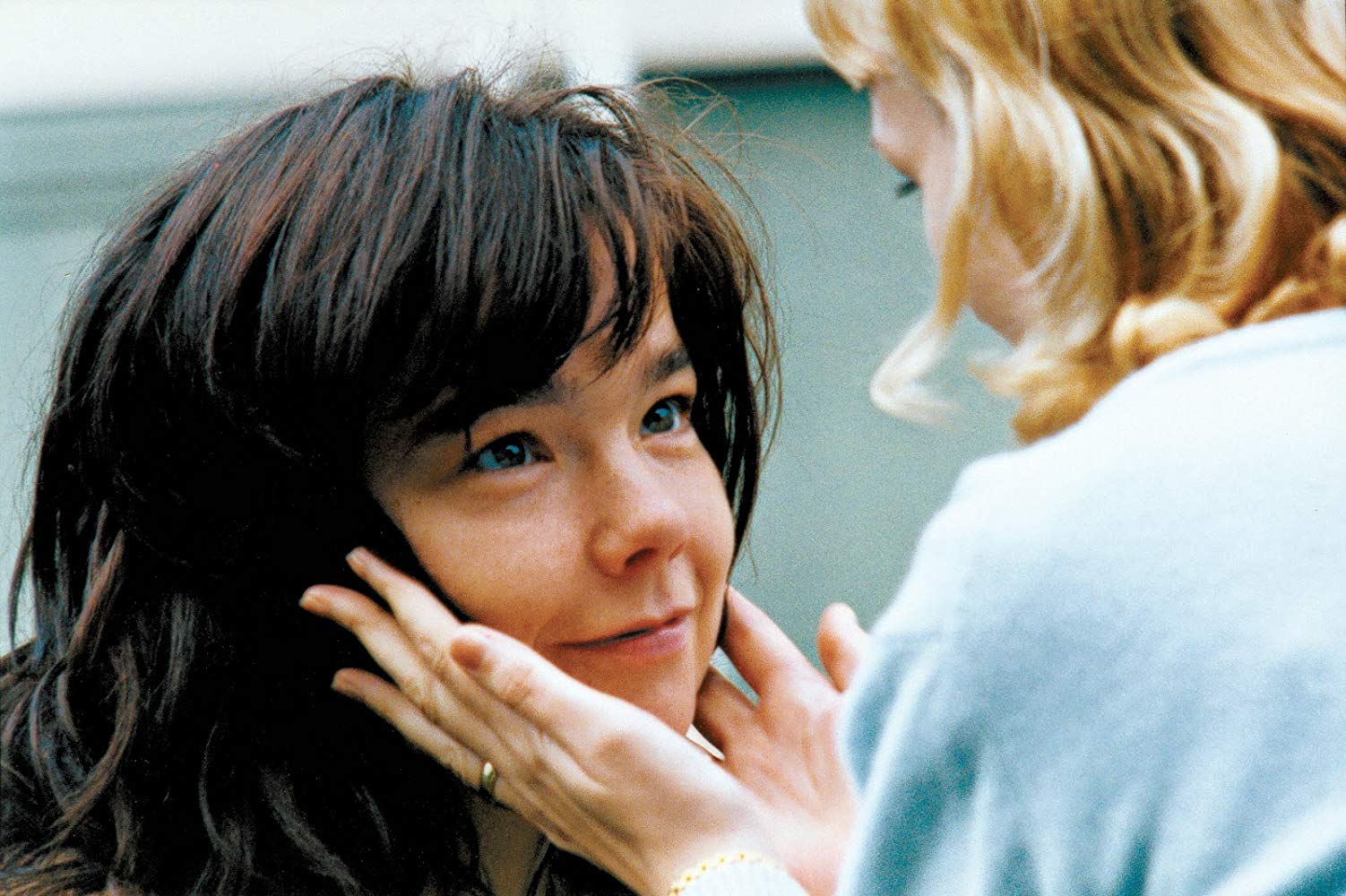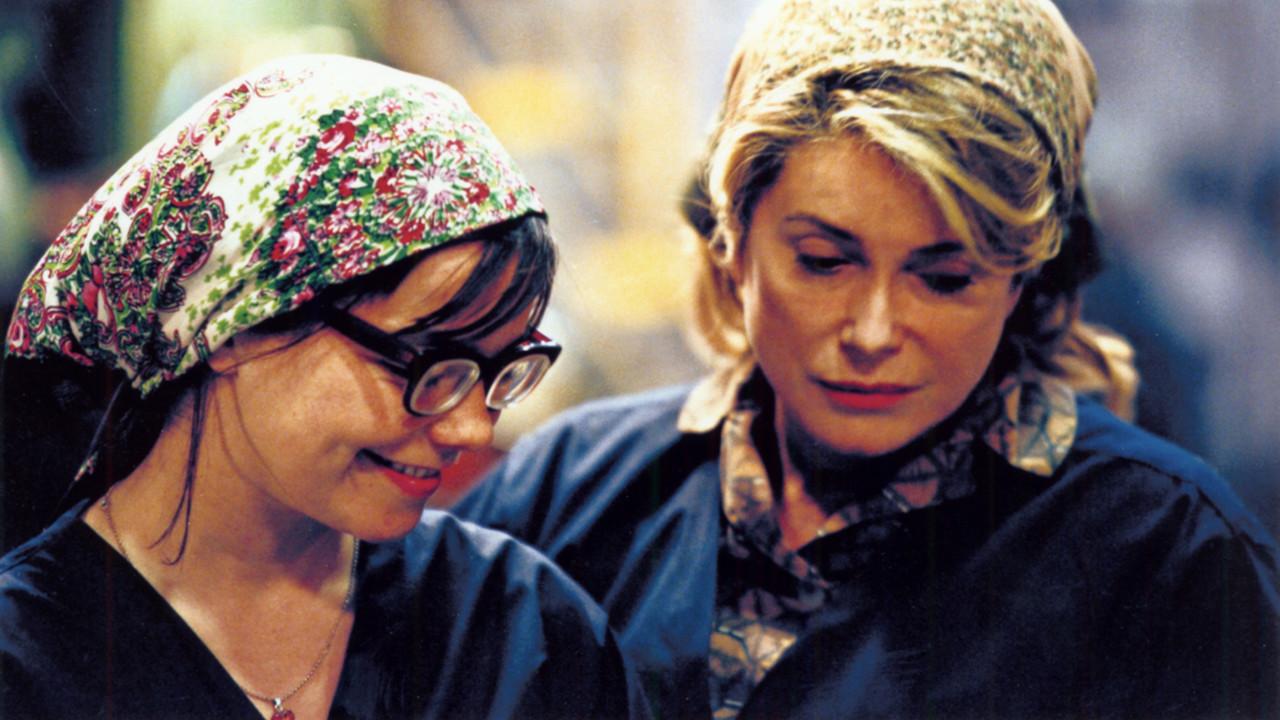4. It Foreshadows and Exemplifies the Melancholy of Björk Guðmundsdóttir

This and the next section shall be digressions from the main focus on von Trier and his films in order to deal with related issues that will elaborate further on “Dancer in the Dark.” It is clear that the film prefigures and exemplifies Björk’s investigations into actual experiences of suffering viewed through body and face, rather than through a technically-based easily-understandable shortcut.
Her major studio albums – e.g. Debut (1993), Post (1995), Homogenic (1997), Vespertine (2001), Medúlla (2004), Volta (2007), Biophilia (2011), Vulnicura (2015), Utopia (2017), all released by London-based label One Little Indian Records – frequently touch on said themes. Consider, as just one example, the following lyrics to her song “Crying” from Debut:
“I travel / All around the city / Go in and out of / Locomotives / All alone / There’s no-one here / And people everywhere / Crying ’cause I need you / Crying I can feel you / Crying ’cause I need you / Crying ’cause I care / It’s a hot day / And I’m dressed lightly / I move carefully / Through the crowd / Here everyone / Is so vulnerable / And I’m as well”
Or the following ones from her song “Black Lake” from Vulnicura:
“Our love was my womb / But our bond has broken / My shield is gone / My protection is taken / I am one wound / My pulsating body / Suffering being / My heart is enormous lake / Black with potion / I am blind / Drowning in this ocean / My soul torn apart / My spirit is broken / Into the fabric of all / He is woven / You fear my limitless emotions / I am bored of your apocalyptic obsessions / Did I love you too much? / Devotion bent me broken / So I rebelled / Destroyed the icon / I did it for love / I honoured my feelings / You betrayed your own heart / Corrupted that organ / Family was always / Our sacred mutual mission / Which you abandoned / You have nothing to give / Your heart is hollow / I’m drowned in sorrows / No hope in sight of ever recover / Eternal pain and horrors / I am a glowing shiny rocket / Returning home / As I enter the atmosphere / I burn off layer by layer.”
5. It Foreshadowed Future Films (e.g. Wonderstruck [2017, Todd Haynes], The Road to Where [2016, Michal Bat-Adams]) That Deconstructed Hollywood Mythmaking

Two recent experimental/avant-garde films by veteran masters, Todd Haynes’s 2017 “Wonderstruck” and Michal Bat-Adams’s (מיכל בת־אדם) 2016 “The Road to Where” (הדרך לאן, which unfortunately has only 10 votes on IMDb as of this writing, though it is already available on an English-subtitled DVD courtesy of Third Ear), could serve as companion pieces to this film’s explorations of an attempt to deconstruct the Hollywood dream/fantasy/mythmaking machine, and the myriad ways it vicariously entraps us.
In the former, a great portrayal of the soul/psyche of a child, a deaf girl in 1927 named Rose (Millicent Simmonds) runs away from her father’s (James Urbaniak) New Jersey home to find her mother/idol, the actress Lillian Mayhew (Julianne Moore, the most beautiful woman in the world, who also plays Rose as an adult in the film’s second part). It is set in 1977 and follows the recently orphaned Ben (Oakes Fegley) as he runs away from his Minnesota home in search of his father.
In the latter, Bat-Adams’s most avant-garde/experimental and demanding work to date, we also follow how loners build their own mythmaking fantasy artificial worlds. A non-narrative set in Israel during 1948, the film tells of a house by the sea in Jaffa, from which Arabs have had to flee in haste, which becomes the home of Jewish survivors who managed to escape the inferno in Europe. It deals with the turmoil of their existence, under the shadow of the unresolved conflict between Jews and Arabs.
6. Its Themes of Sacrifice and Purity of Heart Are Depressing, Uplifting, Awe-Inspiring, and Morally-Ambivalent All the Same

The next section shall elaborate more thoroughly on how von Trier deals with this issue in his entire filmography. In “Dancer in the Dark,” the interrelated themes of sex differences and the good-hearted tendency of women toward loving and selfless self-sacrifice (and love for their children) reach their epitomizing apotheosis when Kathy/Cvalda and Jeff attempt to use the money Selma saved for Gene’s operation in order to hire a private defense attorney (Lars Michael Dinesen) to assist her appeal process. Yet, Selma becomes furious and refuses the lawyer, opting to face the death penalty rather than let her son go blind.
Selma’s dictum of love and self-sacrifice is like how Neuer deutscher film master Helma Sanders-Brahms (20 November 1940, Emden, Ostfriesland, Germany – 27 May 2014, Berlin) chose as the title of her 1997 biographical masterpiece about German-Israeli expressionistic/modernist/avant-garde/experimental poetess Elisabeth Lasker-Schüler (11 February 1869, Elberfeld, North German Confederation – 22 January 1945, Jerusalem) Mein Herz – niemandem! [1]
Awaiting to be executed and sitting on death row, the sympathetic female prison guard, Brenda (Siobhan Fallon), tries to comfort Selma, though state officials are eager to see her executed. On the gallows, she is terrified, so much so that she must be strapped to a collapse board. Selma begins crying hysterically and Brenda cries with her. The film ends with Kathy/Cvalda rushing to inform her that the operation was successful and that Gene will be able to see. Selma is hanged.
7. It Is Part of the Golden Heart Trilogy, Which Initiated Lars von Trier as We Know Him

“Dancer in the Dark” was one of von Trier’s Golden Heart Trilogy films, about naïve heroines who maintain their pure hearts in the face of tragedy; those were the films that defined him and made him who he is today.
It was preceded by 1998’s “Idioterne,” which deals with a bohemian and anti-bourgeois group of adults who attempt to épater la bourgeois and “break down fascistic power structures” (and the like) by acting in public as if they were mentally retarded, only for the audiences to discover that they act out only as a result of some kind of infantile adolescent angst and rebelliousness against their families, parents, and neighbors.
Karen (Bodil Jørgensen), one such member of the commune, had been missing for two weeks, following the death of her young baby. Her attempts to act mentally retarded in front of her family (in order to shock them) by dribbling the food she is eating results in a violent slap from her husband, Anders (Hans Henrik Clemensen). “Idioterne” remains a forceful battle cry against the virtue-signaling and childishness of so-called “social justice” masquerading as “change-the-world” politics and social consciousness.
Breaking the Waves (1996), the first film in that trilogy, which also tells of a pure-hearted and naïve woman, Bess McNeill (Emily Watson), whose husband, Jan Nyman (Stellan Skarsgård), is severely injured in an industrial accident and perseveres in her own sexual debasement as she believes it will cure him, was described by critic David Sterritt in his Criterion Collection Blu-ray insert , thusly:
“Von Trier put the creativity and integrity of the performances at the dead center of the production, freeing the actors to improvise and expand on his screenplay, which he regarded as a mere blueprint or outline for the picture. ‘Breaking the Waves’ is not an exercise in style, though. It’s a journey into the human heart, so the [characters] are what matter most, [an] innocent young woman who lives on an island off Scotland’s northern coast, [the] film begins with a close-up of Bess answering questions from the church elders about her impending marriage to Jan, an outsider who works on an offshore oil rig[, a] virile yet gentle man who loves Bess despite—or because of—her unsophisticated ways and slightly simple mind. The early days of their marriage are full of intimacy and happiness, as Bess discovers the delights of sex and Jan finds hidden depths in her outwardly childish personality. Gradually, we realize that Bess also has a dark side, instilled by the church’s dreary rigidity. At times of need, she has conversations with a God who seems wholly real and present to her, full of the strictness and rebuke that her cheerless elders—including her mother (Sandra Voe), who sides with the church against her daughter—have filled her head with all her life. Bess turns to God more ardently than ever when Jan goes back to work on the oil rig, praying that he’ll come back quickly and never leave again. But her entreaties are not just unheard, they’re turned into a cruel travesty when an accident leaves Jan permanently paralyzed from neck to toes. Could this horrific event be the response of a mocking, malicious God to Bess’s prayers for her husband’s speedy return? If so, the deity she has internalized is as callous and uncaring as the petty patriarchs who run the local church, and we shudder to think how this will affect her naïve trust in family, community, and divine providence itself. Von Trier now ratchets up the tension by having Jan place a startling, even shocking responsibility on his traumatized wife. He implores her to find another man, have sex with him, and describe it to him back at the hospital. Driven by her fervent love for him, she decides she must do absolutely anything he wants or needs, and so she becomes a sort of apathetic hooker in a grim parody of the genuine love life she and Jan once enjoyed.”
Von Trier, in an interview also reprinted in the Criterion Collection Blu-ray insert, noted that “[f]eminists have probably become better behaved over the years. A decade ago, they had more gumption. They’d probably have liked to see me castrated then.”
“Antichrist” (2009), which deals with a feminist academic (Charlotte Gainsbourg) systematically putting her son’s shoes on the wrong feet, resulting in pain and deformity, eventually watching him climbing up to a window, yet intentionally doing nothing to stop it despite clearly noticing it (he falls to his death), has been described by critic Ian Christie, in his Criterion Collection DVD insert , as such:
“We may wonder why von Trier seems to vindicate the history of medieval misogyny and witch persecution, as if seeking to overthrow centuries of enlightened progress[,] von Trier has always thrived on assaulting ‘good taste’ and conventional pieties, and here he has mobilized the resources of horror cinema to delve into the long history of ‘monstrous femininity’ and misogyny—not to reassure us that it’s all in the past, or easily curable by therapeutic platitudes, but to make us feel the true horror of facing our buried fears and conflicts. And that is surely the aim of art that matters.”
[1] Vide Elisabeth Lasker-Schüler. Die gesammelten Gedichte, mit »Else Lasker-Schüler,« S. 7–8 von Peter Hille. Leipzig: Kurt Wolff Verlag, 1917.]
Author Bio: Mr. Gal Ben-Kochav, B.A., M.A., received his B.A. (2013) and M.A. (2016) in Sociology and Anthropology from the School of Social and Policy Studies, Gershon H. Gordon Faculty of Social Sciences, Tel Aviv University. He spent the last couple of years writing a (yet-unpublished) draft of a lengthy scholarly monograph, in Hebrew, dealing with the application of evolutionary psychological theory in the study of social (ethnic- and sex-based) stratification and structure in Israel, currently standing at 1,086 single-spaced pages in Times New Roman standardized at a font of 12. He has long been interested in art, avant-garde/experimental, and independent cinema.